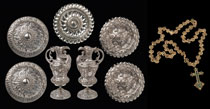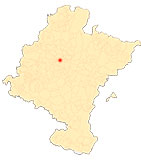Treasure of San Fermín
By Ignacio Miguéliz Valcarlos
bequest Armendariz
One of the most fabulous of the donations given to San Fermín is the items sent from Lima by Don José de Armendáriz y Perurena, Marquis of Castelfuerte and Viceroy of Peru. This bequest consists of five trays and two large silver jugs, as well as a set of gold chain and a gold and emerald pectoral, all of which are still preserved today. The germ of this donation probably lies in the letter sent by the Town Council to residents in other cities and kingdoms requesting their financial aid to finish the work on the chapel, as Castelfuerte himself had collected 4,000 pesos of double columnar silver from Navarrese residents in Peru as financial aid for the construction of the chapel. The chain and pectoral were valued in 1925 at 17,000 pesetas, while five years later, in 1930, the whole set was estimated at 29,241 pesetas.
Indeed, on the seventh of January 1730, Field Marshal Francisco de Armendáriz asked to be received by the Regiment of the city, which was meeting at that time, and in his presence one of the aldermen, Miguel de Ibero, communicated a letter from the Marshal's brother, the Marquis of Castelfuerte and Viceroy of Peru, in which he "sends by his brother's hand for the Glorious San Fermin, a gold pectoral adorned with twenty emeralds, and a chain of the same subject, five silver fountains and two silver vases", all for the devotion that the viceroy felt for San Fermin. The Regiment, in thanksgiving for such a generous gift, decided to celebrate a mass with a Te Deum the following day in the chapel of the Saint, accompanied by music and the wax necessary to illuminate the altars, and attended it as a body corporate, accompanied by many citizens, returning to the town hall after the end of the mass in the same way.
The trays have a circular profile , all of them with a central circular button on which are inscribed the heraldic arms of Don José de Armendáriz, first and fourth two towers, and second and third two cows, framed by a rich panoply of flags and military trophies. Four of the fountains are paired two by two, while the fifth is loose. The first pair has a flat rim separated from the undulating rim by a thick moulding, a concave field and a bulbous seat. The entire piece is covered with dense, fleshy vegetal decoration, which is distributed in concentric bands formed by bulbous and ogee-shaped elements that inscribe flowers, flower buds and birds, and which surround the convex seat. The second pair of trays is articulated by a flat border with a moulded edge and a concave field with a convex emblem. The entire surface is richly decorated with radially positioned vegetal elements consisting of vegetal scrolls with leaves and fruit arranged symmetrically around stylised stems. Finally, the last of the trays has a rim and field decorated with concave gadroons and a convex emblem framed by a border of vegetal elements, the richness of which is due to the play of curves on its surface and the chromatic and luminous effects that this produces, rather than the profusion of vegetal elements that we see on the other four pieces.
The jugs are works of singular importance, both for the rarity of their typology and for the richness of their forms and the finesse of their execution. They are articulated by means of a tripartite circular base, with a convex body between two straight plinths. Then there is a vessel with a mixtilinear profile , with a strangled lower part, a convex body and a cylindrical neck with a corrugated mouth with a broken profile and a warped pouring spout. It has a handle in the shape of an 'ce', and in front of it, under the pouring spout, a winged mermaid figure with phytomorphic limbs. The entire surface is richly decorated with vegetal scrolls, flowers and scallops, which on the sides of the vessel are surrounded by oval-shaped roundels of pearlescent profile , with the heraldic arms of the Marquis of Castellfuerte engraved on them, framed by two angels.
Finally, the Marquis of Castelfuerte's bequest includes a gold chain and a gold and emerald breastplate. The chain is articulated by means of two models of links, both composed of two convex gold plates, openwork and cut out, the first of which is tetralobulated with geometric decoration, and the second in a windlass, which are joined together by means of handles on the bias. A chain similar to this one is preserved in the treasure of Saint Agatha in Catania Cathedral, Sicily. While the breastplate is composed of a Latin cross set on the front with twenty table-cut emeralds, with the finials formed by emeralds arranged in a lozenge, the lower part is larger development, with several emeralds on a board, and with the profile of the terminations covered by a cresting of 'caes', replaced on the arms by a grooved moulding. The reverse is decorated with scrolls and vegetal elements arranged in a symmetrical candelieri pattern on a grid background. Similar pieces to this one are a cross donated to the Virgin of Guadalupe in 1692 by Don Antonio de Guzmán, Bishop of Segovia, or the one belonging to the treasure of the Virgin of Gracia in Carmona.
The donor of these works, Don José de Armendáriz y Perurena, Marquis of Castelfuerte, was a Knight of the Golden Fleece and Commander of Chiclana in that of Santiago, Captain General of the Royal Armies and Lieutenant Colonel of the Spanish Guards, being Viceroy and Captain General of Peru between 1724 and 1736. In addition to the pieces donated to San Fermín, he made bequests to other images in the capital, such as the Virgins of the Sagrario and the Camino, to whom he gave two silver lamps and a gold chain each, in the former case in response to the Pamplona cathedral chapter's sending some prints and medals of the Virgin, which had been commissioned in Rome by the archdeacon of the Chamber, Don Pascual Beltrán de Gayarre. He also contributed to the furnishing of the convent of La Encarnación in Corella, to which he sent, in addition to sums of money, pieces of silver and also paid for the construction of several altarpieces. Thanks to his will, we also know of several items of jewellery that he handled. Thus, he linked his assets to two entailed estates, to the main one of which, at the head of which he placed the degree scroll marquis and the palace in Pamplona, he added, among other things, a three-piece enamelled gold bustle, with sixty-seven diamonds and forty-seven rubies, valued at just over 75,000 reales, a rapier, a sword, a sword and a sword, a sword and a sword.75,000 reales, a gold rapier with three hundred and sixty-one diamonds and a gold cane with a gold handle with another eighty-five diamonds, to which should be added pieces of silver weighing approximately fifteen hundred marks.
-
ANDUEZA UNANUA, P., La arquitectura señorial de Pamplona en el siglo XVIII. Familia, urbanismo y ciudad, Pamplona, Government of Navarre, 2004.
-
ARBETETA MIRA, L., "Cadena y cruz pectoral del tesoro de San Fermín", in ARRAIZA FRAUCA, J., San Fermín patrono, Pamplona, Pamplona City Council, 1989.
-
ARRAIZA FRAUCA, J., San Fermín. El santo, la devoción, la fiesta, Pamplona, Pamplona City Council, 2002.
-
GARCÍA GAINZA, M. C., and others, Catalog Monumental de Navarra. V***. Merindad de Pamplona, Pamplona, Government of Navarre-Archbishopric of Pamplona-University of Navarre, 1997.
-
HEREDIA MORENO, M.C., "Ejemplos de mecenazgo indiano en la capilla de San Fermín de Pamplona", in yearbook de programs of study Americanos, Tomo XLVI, 1989.
-
HEREDIA MORENO, M.C., "Bandejas y jarras del tesoro de San Fermín", in GARCÍA GAINZA, M.C., and FERNÁNDEZ GRACIA, R., (coords.), Juan de Goyeneche y el triunfo de los navarros en la monarquía hispánica del siglo XVIII, Pamplona, Fundación Caja Navarra, 2005.
-
HEREDIA MORENO, M. C., ORBE SIVATTE, M., and ORBE SIVATTE, A., Arte hispanoamericano en Navarra. Plata, pintura y escultura, Pamplona, Government of Navarre, 1992.
-
MIGUÉLIZ VALCARLOS, I., "El tesoro de San Fermín: Donación de alhajas al Santo a lo largo del siglo XVIII", in Promoción y Mecenazgo del Arte en Navarra. Cuadernos de la Chair de Patrimonio y Arte Navarro, nº 2, Pamplona, Chair de Patrimonio y Arte Navarro, 2007.
-
MIGUÉLIZ VALCARLOS, I., "Sacras con los patronos de Navarra y Pamplona", in FERNÁNDEZ GRACIA, R. (coord.), Pamplona y San Cernín 1611-2011. IV Centenary of the city's vow, Pamplona, 2011.
-
MOLINS MUGUETA, J.L., Capilla de San Fermín en la iglesia de San Lorenzo de Pamplona, Pamplona, Diputación Foral de Navarra, 1974.
-
MOLINS MUGUETA, J.L., "La mitra y báculo dieciochescos de San Fermín", in Diario de Navarra. Extraordinary of San Fermín, Pamplona, 1984.
-
MOLINS MUGUETA, J.L., "Mitra y báculo de San Fermín", in MORALES, A. J., Filipinas, puerta de Oriente: de Legazpi a Malaspina, Barcelona, SEACEX, 2003.
-
MOLINS MUGUETA, J.L., "Mitra y báculo del tesoro de San Fermín", in GARCÍA GAINZA, M. C., and FERNÁNDEZ GRACIA, R., (coords.), Juan de Goyeneche y el triunfo de los navarros en la monarquía hispánica del siglo XVIII, Pamplona, Fundación Caja Navarra, 2005.
-
ORBE SIVATTE, A., Platería del reino de Navarra en el siglo del Renacimiento, Pamplona, Government of Navarre, 2000.
-
ORBE SIVATTE, M., Platería en el taller de Pamplona en los siglos del barroco, Pamplona, Government of Navarre, 2008.












